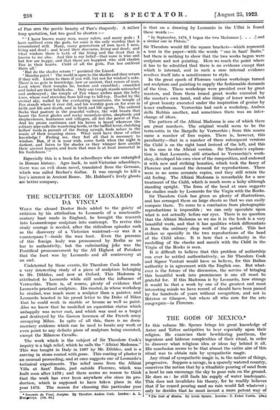THE SCULPTURE OF LEONARDO DA VINCI.*
Mims the absurd Doctor Bode added to the gaiety of criticism by his attribution to Leonardo of a nineteenth- century bust made in England, he brought the research into Leonardesque sculpture into contempt. To revive this study courage is needed, after the ridiculous episodes such as the discovery of a Victorian waistcoat—or was it a counterpane ?—inside the wax bust. Even the presence of this foreign body was pronounced by Berlin as no bar to authenticity, but the culminating joke was the Pontifical pronouncement by the All Highest of Potsdam that the bust was by Leonardo and all controversy at an end.
Undeterred by these events, Sir Theodore Cook has made a very interesting study of a piece of sculpture belonging to Mr. Dibblee, and now at Oxford. This Madonna is attributed to Leonardo while still under the influence of Verrocchio. There is, of course, plenty of evidence that Leonardo practised sculpture. His master, in whose workshop he studied, was much more a sculptor than a painter, and Leonardo boasted in his proud letter to the Duke of Milan that he could work in marble or bronze as well as paint. Also we know that he modelled an equestrian statue which unhappily was never cast, and which was used as a target and destroyed by the Gascon bowmen of the French army occupying Milan. In spite of all this, there is no docu- mentary evidence which can be used to locate any work or even point to any definite piece of sculpture being executed, except the Milanese Cavallo.
The work which is the subject of Sir Theodore Cook's inquiry is a high relief, which he calls the "Albizzi Madonna." This was bought in Italy in 1897 by Mr. Dibblee, and is a
carving in stone coated with gesso. This coating of plaster is an unusual proceeding, and at once suggests one of Leonardo's technical experiments. The relief came from the Albizzi Villa at Sant' Hari°, just outside Florence, which was built soon after 1470; and there seems no reason to think that the work has e'er been anywhere else since its pro- duction, which is supposed to have taken place in the year 1478. The reason for choosing this particular year
• Leonardo do Vinci, Sculptor. By Theodore Andrea Cook. London : A. L. 1Burdicreys. [10e. fid.1 -
is that on a drawing by Leonardo in the Uffi7i is found these words :—
"In September, 1478, I began the two Madonnas [. . . .] and a similar one in Pistoia."
Sir Theodore would fill the square brackets—which represent a tear in the paper—with the words "one in Sant' Dario," but there is nothing to show that the two works begun were sculpture and not painting. Here we reach the point where it has to be admitted that there is no evidence except that which is internal, and in such a case internal evidence resolves itself into a sensitiveness to style.
In the great epoch of Florence various workshops turned out sculpture and painting to supply the fashionable demands of the time. These workshops were presided over by great masters, and from them issued great works executed by the master's own hand, and also things of lesser worth but of great beauty executed under the inspiration of genius by lesser craftsmen. Verroeehio had such a workshop, Andrea della Robbia another, and sometimes there was an inter- change of ideas.
The pattern of the Albizzi Madonna is one of which there are great numbers. The original would seem to be the terra-cotta in the Bargello by Verrocchio ; from this source came a number of free copies. There is, however, this peculiarity—that in a number of these subsequent versions the Child is on the right hand instead of the left, and this is the case in the Albizzi version. Sir Theodore's explana- tion is that Leonardo, still attached to Verrocchio's work- shop, developed his own view of the composition, and endowed it with new and striking beauties, which took the fancy of Florence and caused the demand for reproductions. These were in no sense accurate copies, and they still retain the old feeling. The Albizzi Madonna is remarkable for a new treatment of the Child, which is much more a baby although standing upright. The form of the head at once suggests the studies made by Leonardo for the Virgin with the Rocks.
Sir Theodore Cook has given us plenty of illustrations, and has arranged them on large sheets so that we can easily compare them. To come to a conclusion from photographic reproductions is impossible ; we can only speculate upon what is not actually before our eyes. There is no question that the Albizzi Madonna as we see it in the book is a very beautiful work, and that it has qualities which differentiate it from the ordinary shop work of the period. This last strikes us specially in the two reproductions of the head of the Child alone. It is here that a similarity in the modelling of the cheeks and mouth with the Child in the Virgin of the Rocks is seen.
It is difficult to believe that this problem of authorship can ever be settled authoritatively, as Sir Theodore Cook and Signor Venturi would have us believe, for this Italian authority is in agreement with the English one. But what- ever is the future of the discussion, the service of bringing this beautiful work into prominence is one all must be grateful for. If this Madonna is by Leonardo, how strange it would be that a work by one of the greatest and most interesting minds we have record of should have been passed by for hundreds of years without recognition, and not in Brixton or Glasgow, but where all who care for the arts congregate—in Florence.


































 Previous page
Previous page